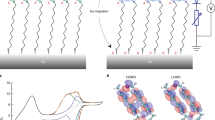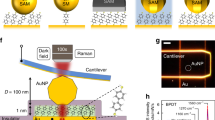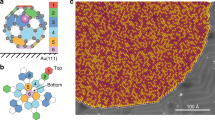Abstract
Molecular electronics has been proposed as a pathway for high-density nanoelectronic devices. This pathway involves the development of a molecular memory device based on reversible switching of a molecule between two conducting states in response to a trigger, such as an applied voltage. Here we demonstrate that voltage-triggered switching is indeed a molecular phenomenon by carrying out studies on the same molecule using three different experimental configurations—scanning tunnelling microscopy, crossed-wire junction, and magnetic-bead junction. We also demonstrate that voltage-triggered switching is distinctly different from stochastic switching, essentially a transient (time-dependent) phenomenon that is independent of the applied voltage.
This is a preview of subscription content, access via your institution
Access options
Subscribe to this journal
Receive 12 print issues and online access
$259.00 per year
only $21.58 per issue
Buy this article
- Purchase on Springer Link
- Instant access to full article PDF
Prices may be subject to local taxes which are calculated during checkout





Similar content being viewed by others
References
Reed, M. A. & Tour, J. M. Computing with molecules. Sci. Am. 282, 86–93 (2000).
Carroll, R. L. & Gorman, C. B. The genesis of molecular electronics. Angew. Chem. Int. Edn 41, 4378–4400 (2002).
Nitzan, A. & Ratner, M. A. Electron transport in molecular wire junctions. Science 300, 1384–1389 (2003).
Chen, J., Reed, M. A., Rawlett, A. M. & Tour, J. M. Large on-off ratios and negative differential resistance in a molecular electronic device. Science 286, 1550–1552 (1999).
Reed, M. A., Chen, J., Rawlett, A. M., Price, D. W. & Tour, J. M. Molecular random access memory cell. Appl. Phys. Lett. 78, 3735–3737 (2001).
Chen, J., Su, J., Wang, W. & Reed, M. A. Electronic memory effects in self-assembled monolayer systems. Physica E 16, 17–23 (2003).
Fan, F.-R. F. et al. Electrons are transported through phenylene-ethynylene oligomer monolayers via localized molecular orbitals. J. Am. Chem. Soc. 126, 2568–2573 (2004).
Donhauser, Z. J. et al. Conductance switching in single molecules through conformational changes. Science 292, 2303–2307 (2001).
Ramachandran, G. K. et al. A bond-fluctuation mechanism for stochastic switching in wired molecules. Science 300, 1413–1416 (2003).
Wassel, R. A., Fuierer, R. R., Kim, N. & Gorman, C. B. Stochastic variation in conductance on the nanometer scale: A general phenomenon. Nano Lett. 3, 1617–1620 (2003).
Chen, J. & Reed, M. A. Electronic transport of molecular systems. Chem. Phys. 281, 127–145 (2002).
Gaudioso, J., Lauhon, L. J. & Ho, W. Vibrationally mediated negative differential resistance in a single molecule. Phys. Rev. Lett. 85, 1918–1921 (2000).
Seminario, J. M., Zacarias, A. G. & Derosa, P. A. Theoretical analysis of complementary molecular memory devices. J. Phys. Chem. A 105, 791–795 (2001).
Seminario, J. M., Zacarias, A. G. & Tour, J. M. Theoretical study of a molecular resonant tunneling diode. J. Am. Chem. Soc. 122, 3015–3020 (2000).
Seminario, J. M., Córdova, L. E. & Derosa, P. A. An ab initio approach to the calculation of current-voltage characteristics of programmable molecular devices. Proc. IEEE 91, 1958–1975 (2003).
Donhauser, Z. J. et al. Matrix-mediated control of stochastic single molecule conductance switching. Jpn J. Appl. Phys. 41, 4871–4877 (2002).
Andres, R. P. et al. “Coulomb staircase” at room temperature in a self-assembled molecular nanostructure. Science 272, 1323–1325 (1996).
Blum, A. S., Yang, J. C., Shashidhar, R. & Ratna, B. R. Comparing the conductivity of molecular wires with the scanning tunneling microscope. Appl. Phys. Lett. 82, 3322–3324 (2003).
Kushmerick, J. G. et al. Effect of bond-length alternation in molecular wires. J. Am. Chem. Soc. 124, 10654–10655 (2002).
Kushmerick, J. G. et al. Understanding charge transport in molecular electronics. Ann. NY Acad. Sci. 1006, 277–290 (2003).
Tour, J. M. et al. Self-assembled monolayers and multilayers of conjugated thiols α,ω-dithiol, and thioacetyl-containing adsorbates. understanding attachments between potential molecular wires and gold surfaces. J. Am. Chem. Soc. 117, 9529–9534 (1995).
Rawlett, A. M. et al. Electrical measurements of a dithiolated electronic molecule via conducting atomic force microscopy. Appl. Phys. Lett. 81, 3043–3045 (2002).
Blum, A. S. et al. Charge transport and scaling in molecular wires. J. Phys. Chem. B 108, 18124–18128 (2004).
Long, D. P., Lazorcik, J. L. & Shashidhar, R. Magnetically directed self-assembly of carbon nanotube devices. Adv. Mater. 16, 814–819 (2004).
Donhauser, Z. J., II, D. W. P., Tour, J. M. & Weiss, P. S. Control of alkanethiolate monolayer structure using vapor-phase annealing. J. Am. Chem. Soc. 125, 11462–11463 (2003).
Blum, A. S. et al. Cowpea mosaic virus as a scaffold for 3-D patterning of gold nanoparticles. Nano Lett. 4, 867–870 (2004).
Acknowledgements
Research support by the Defense Advanced Research Projects Agency and the Office of Naval Research is gratefully acknowledged. We thank S. K. Pollack and J. Lazorcik for helpful discussions. J.C.Y. and D.P.L. thank the National Research Council for fellowship support.
Author information
Authors and Affiliations
Corresponding author
Ethics declarations
Competing interests
The authors declare no competing financial interests.
Rights and permissions
About this article
Cite this article
Blum, A., Kushmerick, J., Long, D. et al. Molecularly inherent voltage-controlled conductance switching. Nature Mater 4, 167–172 (2005). https://doi.org/10.1038/nmat1309
Received:
Accepted:
Published:
Issue Date:
DOI: https://doi.org/10.1038/nmat1309
This article is cited by
-
First-Principles Approach to Elucidating Significant Rectification Ratios in Oppositely Charged Dipeptides
Journal of Electronic Materials (2024)
-
An artificial synapse based on molecular junctions
Nature Communications (2023)
-
A Gd@C82 single-molecule electret
Nature Nanotechnology (2020)
-
Optical probes of molecules as nano-mechanical switches
Nature Communications (2020)
-
Room temperature stable film formation of π-conjugated organic molecules on 3d magnetic substrate
Scientific Reports (2018)



